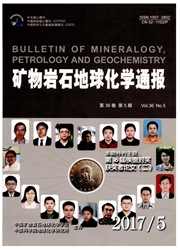

 中文摘要:
中文摘要:
对四川盆地彭水地区奥陶系五峰组剖面黑色页岩中的硬石膏、黄铁矿、方解石脉进行了矿物学分析,结果显示,脉体中硬石膏为溶蚀残余,黄铁矿平行于脉体两边对称分布,从中心至边缘,晶体大小和完整性不断变化,方解石为次生自形晶,这些特征都表明该矿物组合是黑色页岩中发生过TSR的特色矿物组合。溶蚀硬石膏能提供反应所需的硫酸根离子,黑色页岩中有机质及其演化产物提供了还原剂,TSR形成的硫化氢与铁形成的黄铁矿沿脉体分布,方解石主要为成矿流体沉淀所致。这一特征拓宽了高演化阶段成烃流体TSR发生的范畴,证明了TSR在地质条件下的广泛发育,有利于对海相层系油气形成的认识。
 英文摘要:
英文摘要:
We carried out mineralogical analyses to understand the causes of anhydrite-pyrite-calcite veins in the black shales of the Ordovician Wufeng formation, Pengshui area, Sichuan Basin. It is shown that anhydrites are remnants of the original anhydrite dissolution, pyrite develops in both parallel sides with a symmetrical distribution, and its crystal size and integrity are constantly changing from center to edge, and calcite crystals are secondary euhedral. These features indicate that the black shale occurred TSR in the past. Anhydrite dissolution could provide the required sulfate ions, organic matter and the product of black shale evolution could provide reducing agent, hydrogen sulfide formed from TSR and iron could generate pyrite which distributes along the veins, and calcite precipitation was mainly due to ore fluids. All of these broaden the scope of occurring hydrocarbon fluids TSR in the high evolutionary stage, prove that TSR could develop widely in geological conditions, and enhance understanding of formations of oil and gas in marine strata.
 同期刊论文项目
同期刊论文项目
 同项目期刊论文
同项目期刊论文
 期刊信息
期刊信息
